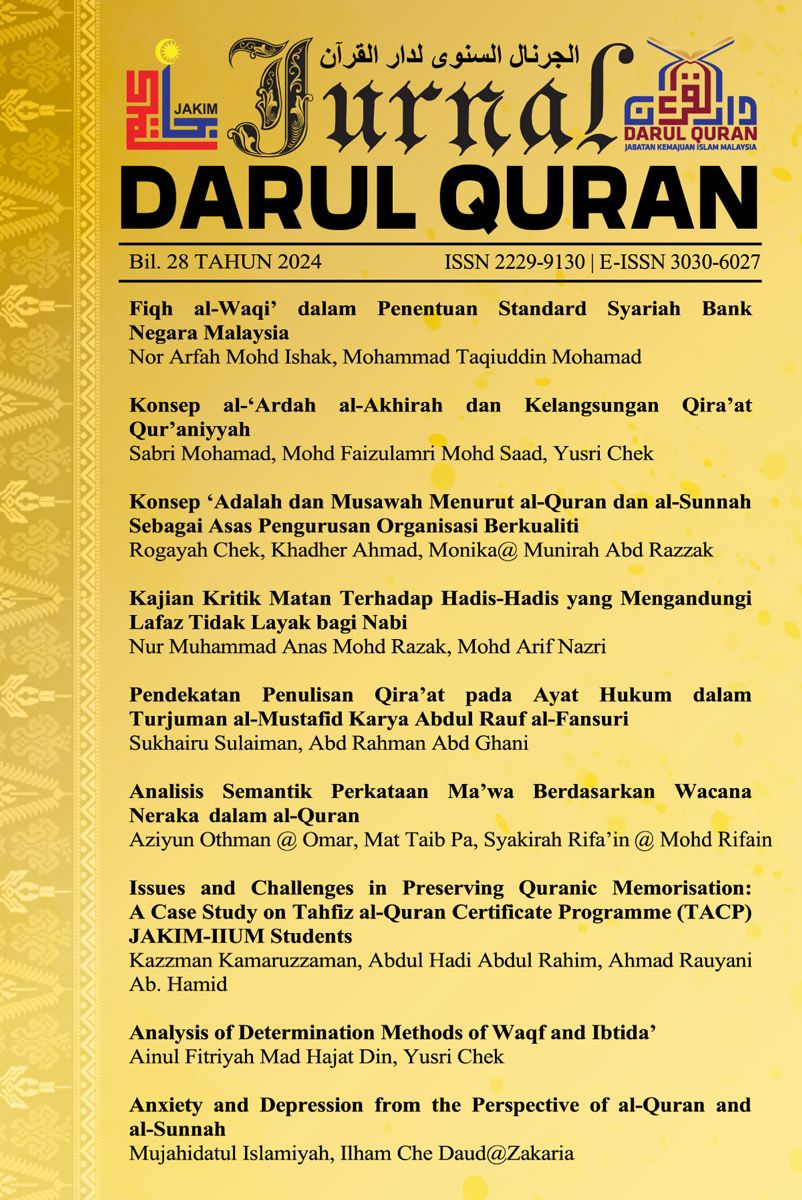Anxiety and Depression from the Perspective of al-Quran and al-Sunnah

Penulis
Ilham bin Che Daud @ Zakaria
Abstrak
Rujukan
Ahmad Taha. (1992). Kedoktoran Islam. (Islamic Medicine). Kuala Lumpur: Dewan Bahasa Dan Pustaka.Al-Bukhari. t.t. Sahih AlBalkhi, A.S. (1987). Masalih al-abdan wa al-anfus. Beirut: Dar al-`Ilm li al-Malayin.
Al-Bukhari. Dr Mustofa Died Al-Bugha. (1993). Sahih al-Bukhari, Kitab al-Mardha, j.5. Damsyiq: Dar Ibnu Kathir
Al-Muslim, Muhammad Fuad Abdul Baqi (1991) Sahih al-Muslim, Kitab al-Zikr, j.4. Kaherah: Dar al-Hadith
Ar-Raghib Al-Asfahani. t.t. Mu’j am Mufrad Al-Afazil Qur’an. j.1.
Qairo: Darul Syuru’. p. 420.
Barlow, D.H. (2002). Anxiety and Its Disorders: The Nature and Treatment of Anxiety and Panic. New York: American Psychological Association p. 292-327.
Bonanno GA. (2009). The other side of sadness: What the new science of bereavement tells us about life after loss. Columbia: Basic Books.
Borkovec, T. D., Newman, M. G., & Castonguay, L. G. (2003). Cognitive-Behavioral Therapy Disorder with Integrations from Interpersonal and Experiential Therapies. The Journal of Lifelong Learning in Psychiatry. New York: Guilford Press p. 393.
Bukhari. Bayrut: Alam Al-Kutub.
Dalgleish et al. (1997). Information Processing in Clinically Depressed and Anxious Children and Adolescents. US:National Library of Medicine
Fariza Md. Sham. (2005). Tekanan Emosi Remaja Islam. (Emotional Pressure Among Muslim Adolescents). Universiti Kebangsaan Malaysia. p. 3-24.
Hairunnaja Najmuddin. (2006). Psikologi Ketenangan Hati. (The Psychology of Inner Peace). Pahang: PTS Publications & Distributors Sdn. Bhd.
Hazan Zaini. (2007). Ensiklopedia Al-Qur’an: Kajian Kosa Kata. (Encyclopedia of the Qur'an: A Study of Vocabulary). Jakarta: Lentera Hati. p.321.
Iswa, A.R.M. (1970). Dirasat Saikulujiyyah. Iskandariah: Mansya’ah al-Nasyir al Ma’aarif.
Jonaki Bose, Sarra L. Hedden, Rachel N. Lipari & Eunice Park-Lee. (2018). Key Substance Use and Mental HealthIndicators in the United States: Results from the 2017 National Survey on Drug Use and Health. U.S. Department of Health and Human Services (HHS).
Julianto V & Subandi. (2015). Membaca Al Fatihah Reflektif Intuitif Untuk Menurunkan Depresi Dan Meningkatkan Imunitas. (Reflective Intuitive Recitation of Al-Fatihah to Reduce Depression and Boost Immunity). Indonesia: Faculty of Psychology Universitas Gadjah Mada
Kase, L. & D.R. Ledley. (2007). Anxiety Disorder: The Wiley Concise Guides to Mental Health. America: JohnWiley and Sons. p: 30- 31.
Kessler RC & Wang PS. (2018). The descriptive epidemiology of commonly occurring mental disorders in theUnited States. US: National Library of Medicine
Kessler RC, Sampson NA, Berglund Petal. (2015). Anxious and non- anxious major depressive disorder in the World Health Organization World Mental Health Surveys. US: National Library of Medicine.
M Jahanshahi ZA et al. (2014). Adjustment Models and Its Relationship with Mental Health Imam Sajjad Ramsar Hospital Nurses Persian. Iran: Urmia University of Medical.
Muhammad Faud Abdul Baq. (1981). Al-Mu’jam Mufarras lil Fadzal lil Qur’anul Karim. Indonesia: Maktabah Dahlan. p. 314
Muslim bin Al-Hajjaj. t.t. Sahih Muslim. Beirut: Dar Ihya Al-Turath Al- ‘Arabi. n.a. (2004). Anxiety Disorders Association of America. http://www.adaa.org/AboutADAA/PressRoom/St ats&Facts.asp>
Ned H. & Kalin, M.D. (2020). The Critical Relationship Between Anxiety and Depression. US: National Library of Medicine. p. 365
Ramli Hassan. (1990). Pengantar Psikiatri. (Introduction to Psychiatry). Kuala Lumpur: Dewan Bahasa Dan Pustaka.
Ris’an Rusli. (2007). Ensiklopedia Al-Qur’an: Kajian Kosa Kata. (Encyclopedia of the Qur'an: A Vocabulary Study). Jakarta: Lentera Hati. p. 474.
Robert, J.E. (1992). Anxiety Theory. New York: Research and Intervention in Clinical and Health Psychology.
Thackery, E. (2003). The Gale Encyclopedia of Mental Disorders. The Gale Group, Inc.Utz A. (2011). Psychologyfrom the Islamic perspective. Riyadh, Saudi Arabia: International Islamic publishing house.
Water, A.M. & M.G. Craske. (2005). Generalized Anxiety Disorders. New York: Guilford.
Yousef Aazami & Esfandiar Azad Marzabadi. (2017). Stress Management Model Pattern According to Quran and Hadith. Stress Management Model Pattern. Iran: Allameh Tabataba'i University p. 170-172
Zainul Kamal. (1999). Menuju kesempurnaan akhlak. (Towards the Perfection of Morality). Helmi Hidayah. Bandung: Mizan.
